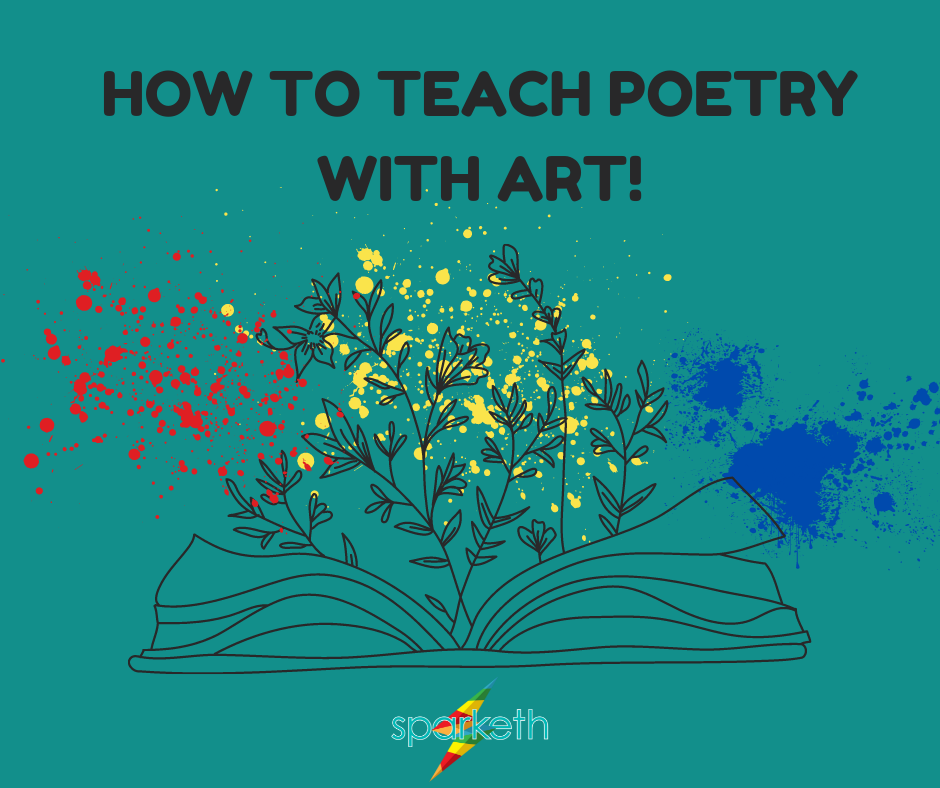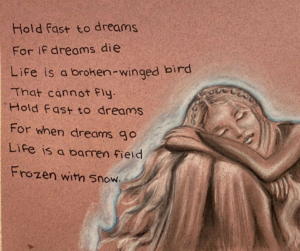Have you ever noticed that creative people usually enjoy art in more than one form? Think about the creative individuals that you know (probably including yourself), and I bet you’ll start to notice the trend. In fact, many creatives tend to have a lot of fun combining art forms when possible! This month is National Poetry Month, and Sparketh is exploring 5 ways to teach poetry with art.
Before you start telling yourself things like, “But wait, I’m not a poet,” let me stop you there. Combining art and poetry does not have to be complicated. It’s not about perfection, or even technique. Instead, it’s all about exploration and fun. As you connect meaningful words with visual art, you may even find yourself relaxing and connecting to themes and ideas that you didn’t even know were floating around in your brain!
Personally, I find that creative challenges (like connecting art and poetry) often give just the right amount of structure and direction to inspire and motivate me, and I hope that’s the case with you, too. Here are 5 easy ways to connect art and poetry. Try these ideas to learn more about poetry and create your own unique masterpieces!
1. Blackout Poetry
Blackout poetry is a fun and relaxing creative activity for all artistic levels and ages. Essentially, you take discarded paper media (books, magazines, or newspapers you don’t want to read anymore) and use it as a template to guide your blackout poetry. You’ll start by choosing a page and finding the words that jump out to you most. These words will make the basis of your poem, and you’ll black out all of the other words (the ones that you didn’t select).
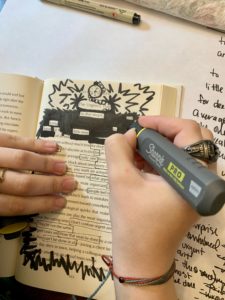
After you’ve blacked out the words you don’t want, you can go back over those parts of the page and create designs or artwork to complement your blackout poem! I wrote a more detailed tutorial about how to do it here, so be sure to check that out if you like step-by-step instructions!
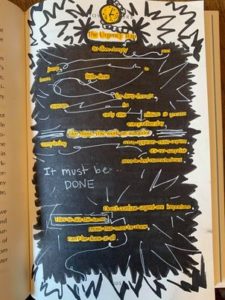
Artist Credit: Emma Powell
2. Create a Work of Art That Incorporates a Word or Phrase
Do you have a word(s), phrase, or message that means a lot to you? If so, why not use it as inspiration for a work of art? This approach doesn’t require you to necessarily incorporate a traditional poem. However, creating visual art around a single word or expression will expand that particular word’s meaning, power and resonance to the viewer. This is something that great poetry often does as well (just in a different way).
Start out by writing your word or phrase and brainstorming about it’s significance and meaning to you. What images, colors, and feelings come to mind when you think of your word(s)? The visual components that you come up with don’t need to be obvious (in fact, your art will probably be better and more original if it’s not), but the connections between the word(s), color choices, and images have to mean something true to you.

There are many great contemporary artists who feature words in their art to create a powerful message or draw attention to a concept or theme. You can check out some of these artists and their work by clicking this link.
3. Write a Poem Inspired by a Work of Art (Ekphrastic Poetry)
If you are an art enthusiast who wants to flex your creative writing muscles, then you may enjoy the challenge of writing a poem about your favorite work of art. There is actually a name for this type of poem; it’s called an ekphrastic poem.
If you want to write an ekphrastic poem, start out by choosing a favorite work of art for inspiration. Study it.
What is the scene being set by the image? What colors, textures, figures, or symbols speak to you or create strong images in your mind? What themes are at work?
Brainstorm words and phrases for your poem as you consider these types of questions, then begin constructing your poem, line by line, according to your poetry form of choice (or in free verse, if you prefer).
One tip for writing powerful poetry? More is less. That’s why poets are infamous artists of revision. So write your first draft and let it sit awhile. Then revisit and revise, taking out the words that don’t add impact to your poem.
If are a teacher (or #homeschoolteacher) this would also be a great way to include some art history into a writing activity, or some creative writing into art. Overall, I think ekphrastic poems provide a valuable way to think about what speaks to us in our favorite works of art.
4. Create a Work of Art that Represents Your Favorite Poem
This poetry and art activity is the the exact inverse of the last one! Whereas ekphrastic poems put art into words, this activity is all about creating art that visually represents a poem that you love.
First, start out by choosing a poem that speaks to you. It can be a be a well-known poem, a lesser known one, or even one that you write yourself! As you think about the poem, consider why you like it. Brainstorm about what you will draw to reflect the poem’s meaning (either an objective/literal meaning or a personal one). Two members of the Sparketh team tried this exercise at home, which you can see below!
Maria, who you can watch doing weekly art demonstrations on our Youtube channel, used part of Langston Hughes’ famous poem, “Dreams” as inspiration for the artwork below. Her drawing (featured below) shows a sleeping girl, surrounded in a surreal haze which represents her dreams.
Artist Credit : Maria Sandoval
Poem: “Dreams” by Langston Hughes, 1922
(Watch her create this piece on our Youtube channel!)
Becca, a Sparketh instructor you may recognize from some of our online art courses, shared the below piece with the students in Sparketh Community. The poem that Becca selected reminds her of her relationship with her sister, so her drawing reflects her personal connection with the poem.
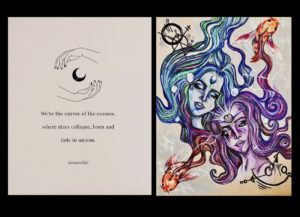
Artist Credit: Becca Scoggins
Poem by AnaSoulful
Check out the free Sparketh Community here
There’s no wrong way to do this activity (or really any of these activities). The important thing is to enjoy connecting with words and finding ways to represent them through art!
5. Create Art From Words (Concrete Poetry)
We’ve talked about ways to use words in your art, but did you know that you can create art out of words? Concrete poetry (also known as shape poetry) involves writing poems in such a way that the shape of the poem creates a visual image.
This gives the poem visual meaning, in addition to written meaning. Poets who write concrete poetry make very deliberate choices about where each line of their poems will naturally end, so that the poem’s words, and its shape, flow together to create a unique work of art/poetry. Check out the below image to get an idea of what this can look like.
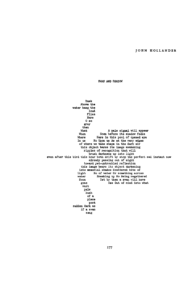
Poem: “The Swan and the Shadow,” by John Hollander, 1966
You can have fun connecting words and poetry by writing your own concrete poetry! Especially if you’re working with kids, it is easiest to choose a simple topic, such as a favorite activity or animal. Hint: Think about something that will visually translate well as a simple shape on the page that you can fill with words. Next, outline the shape of your topic on the page. Brainstorm adjectives, descriptions and short lines as your words for the concrete poem. Lastly, put it all together by arranging your final word selection into the shape you outlined! If this is your first attempt at concrete poetry, remember that it’s perfectly okay to keep things simple. This is a fun challenge that is great to do together as a family–even young kids will enjoy it!
It’s always a good idea to mix things up and be creative with how we see the world around us, and these 5 ideas for connecting art and poetry will have you stretching those creative muscles and hopefully feeling inspired, too! Whether you are a student or an adult, we hope you enjoy trying these activities out at home, in your classroom, or in your homeschool! Let us know which ideas you try!


